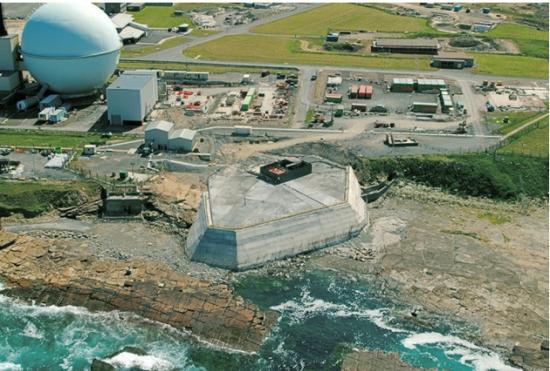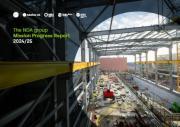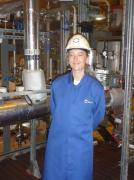Contract For World's Deepest Nuclear Clean-up Awarded At Dounreay
16th September 2020

Dounreay has awarded a major contract as the world's deepest nuclear clean-up job gets underway.
Dounreay Site Restoration Ltd (DSRL), on behalf of the Nuclear Decommissioning Authority, awarded the £7.5 million contract for "advanced transition works" at the 65 metre deep shaft and silo to Nuvia and its partner Graham Construction, through the site's decommissioning framework following a competitive tendering process. Nuvia is an international nuclear engineering, project management, products and services contractor.
The work will include the rerouting of existing services as well as minor construction and demolition works, preparing the 2 waste facilities to be emptied of legacy higher activity waste.
DSRL Programme Delivery Director, David Hubbard, said:The shaft and silo contain solid waste and sludge which must be retrieved and repackaged for safe above-ground storage. I'm very pleased that we are one step closer to the clean up of these historic waste facilities through the award of this contract.
Physical work on site is expected to take place in late autumn 2020. In the meantime the company has been delivering activities remotely.
DSRL is the site licence company responsible for the clean-up and demolition of Britain's former centre of fast reactor research and development. A wholly-owned subsidiary of the Cavendish Dounreay Partnership, it is funded by the NDA to deliver the site closure programme.
The Dounreay waste shaft. Shaped like a cylinder, 4.6 metres across and 65.5m deep, it was excavated in the 1950s to allow the removal of rock spoil during construction of an under sea tunnel that would be used for the discharge of low level liquid effluent to the sea. On completion a concrete plug was used to separate the shaft from the tunnel and it was allowed to fill with groundwater.
In 1958 the Scottish Office authorised the UKAEA to use the shaft as a disposal facility for radioactive waste. Today, no-one would authorise such a facility because much better techniques are available for the management of such waste - but it does illustrate how very different the thinking was in the 1950s and how knowledge has increased.
More than 11,000 disposals took place until 1977, when some sodium reacted with the water, ignited and blew off the roof. The radioactive waste is all beneath the water and the blast occurred in the gas space above it, so forcing the roof off. The environmental consequences of this were minimal but it has generated a lot of media interest in the past.
Dounreay - The First Fifty Years
Early Dounreay Pictures
Related Businesses
- Dounreay Stakeholder Group
- Nuclear Decommissioning Authority
- Dounreay
- Cavendish Dounreay Partnership Ltd
Related Articles
TAE Technologies and UKAEA partner to commercialise fusion tech
Joint venture to develop neutral beams for fusion and non-fusion applications, creating high-skilled jobs and establishing a critical supply chain. TAE Technologies, a leading US private fusion energy firm with over 25 years at the forefront of scientific innovation, today announces a bilateral and reciprocal investment commitment with the United Kingdom's national fusion laboratory, the UK Atomic Energy Authority (UKAEA) to commercialise TAE's proprietary particle accelerator technology for the global market.
Buried Hazards, Unfinished Business - What the NDA's 2025 Progress Report Really Tells Us
The Nuclear Decommissioning Authority (NDA) has released its 2025 Mission Progress Report is a slightly sprawling document chronicling one of the UK's most complex environmental undertakings. The safe dismantling of its early nuclear legacy.
New recruit officers join the Civil Nuclear Constabulary
The Civil Nuclear Constabulary (CNC) welcomes its newest recruits. The CNC hosted two passing out parades for the graduating Authorised Firearms Officers (AFOs) of Initial Foundation Programme (IFP) 106.
Dounreay's next generation of talent honoured by apprentice award
Nuclear Restoration Services Dounreay's Kate Thomson has won Modern Apprentice of the Year at the Highlands & Islands Apprenticeship Awards in Inverness. Kate, who is in the second year of her apprenticeship in commercial and quantity surveying, said she was thrilled by the honour.
Taskforce calls for radical reset of nuclear regulation in UK
Nuclear Regulatory Taskforce publishes final report and calls for radical reset of overly complex nuclear regulatory system. An overly complex nuclear regulatory system has contributed to the "relative decline" of the UK's ability to deliver faster and cheaper nuclear projects.
NDA working with private developer to accelerate Chapelcross Hub
The NDA group has announced it's working with CX Power as the strategic developer to support the delivery of the green energy hub masterplan at Chapelcross. The Nuclear Decommissioning Authority (NDA) group has announced it's working with CX Power as the strategic developer to support the delivery of the green energy hub masterplan at Chapelcross, a programme set to transform the region.
Funding approved for Wick Harbour port consultant
A specialist ports consultant has been appointed to develop a long-term strategic plan for Wick Harbour Authority (WHA) in Caithness. WHA has secured £47,775 from Highlands and Islands Enterprise (HIE) and the Nuclear Restoration Services, NRS Dounreay towards the cost of the services.
NDA announces £1 million funding to accelerate clean energy in West Cumbria
NDA announces £1 million investment to develop masterplan for clean energy development on land adjacent to Sellafield. The Nuclear Decommissioning Authority (NDA) has announced today it's investing £1 million of funding to develop the masterplan for a clean energy development on land adjacent to Sellafield, known as Pioneer Park.Fallon Campbell From Melvich Near Thurso Named As Apprentice of the Year At Awards In London
Rising star from North Scotland honoured at event to celebrate brightest and best in industry. An electrical apprentice from North Scotland is celebrating after being recognised for her contribution to industry at the 13th annual Engineering Construction Industry ECI Training and Development Awards in London.
The NDA Group Graduate Programme: more than a job
The NDA group graduate scheme offers far more than just a stepping stone into the nuclear industry; it's a chance to grow professionally, explore new places, and become part of a supportive community. Nuala Ledward, Assurance and Performance Graduate, shares how her secondment to Dounreay brought these benefits to life.
